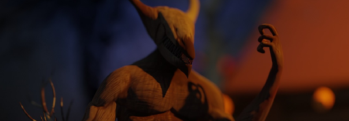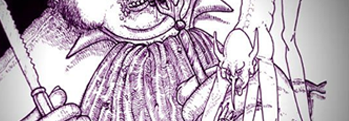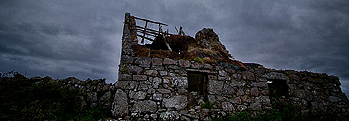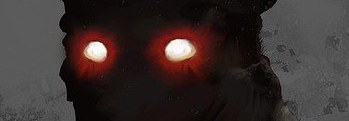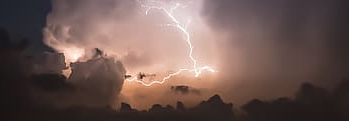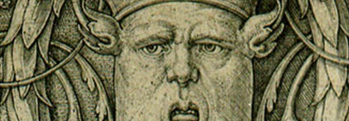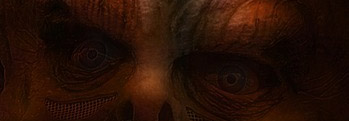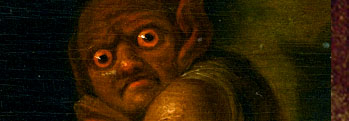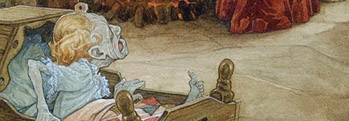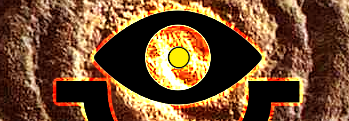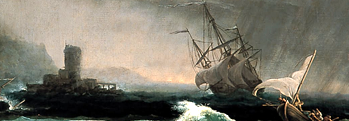The Pooka
Irish and Celtic myths and legends, Irish folklore and Irish fairy tales from Irish Gods and Monsters
The rider of the crossroads, The Pooka
The Pooka or Puca is one of the most ancient fairy creatures of Ireland, and is known further abroad as well, called Puck or Pook. In some places he is feared and in others respected. He can take many shapes, most commonly that of a wild horse wrapped in chains with sulfurous or blazing crimson eyes - the night mare - a huge dog, a raging bull, a handsome young man or lovely woman often with an animal's tail or hooves, but always he could speak with the voice of a person, and it is said the old peoples used to take counsel from the wisdom of the Puca at the tops of hills and high places.
 In those times they were far more numerous than today, and farmers would always leave a portion of their crops out after Halloween for the one day when the Puca would feast, on November the first. After that day the Puca would spit on any wild blackberries or fruit still in the fields, making them dangerous to eat. Other legends speak of the Puca as a vampire or eater of human flesh!
In those times they were far more numerous than today, and farmers would always leave a portion of their crops out after Halloween for the one day when the Puca would feast, on November the first. After that day the Puca would spit on any wild blackberries or fruit still in the fields, making them dangerous to eat. Other legends speak of the Puca as a vampire or eater of human flesh!
In County Down, the Puca was a wizened little hobgoblin who'd show up at peoples' houses demanding its share of the crops. In Laois it was a terrifying shadowy phantom, chasing after lone travellers after the sun had set. To the south, he takes the form of a great eagle or bird of prey, and in the midlands the Puca is a black goat.
Late at night they would terrorise the countryside, sneaking up behind travellers drunk or sober and pushing between their legs, taking them for a wild and terrifying midnight ride across the land, bringing them to any place on earth that took its fancy. Other mischiefs they would wreak, breaking down fences and destroying property, spoiling crops and causing harm to livestock. Even the sight of a Puca would stop the cows from giving milk and the hens from laying eggs.
Other legends speak of the Puca joining groups of travellers, befriending them, and speaking knowingly of their past as well as predicting future catastrophes that would befall them. Then he would take himself off to a hole under the hills, chuckling as he watched these events unfold.
One account from the 19th century tells of an encounter with the Puca:
"In November 1813, Kildare Hunt known as Killing Kildares set out. Having indulged in traditional stirrup cup at Tipper crossroads, near Naas, hunt failed to raise a fox until it was approaching Tipperkevin, north of Ballymore Eustace, county Kildare. Here a large fox appeared and led a course towards Liffey. Simultaneously, an un-mounted black horse appeared, that did not belong to any of riders. It was Pooka!
The terrain was difficult and fox ran fast, so that near the Liffey, only one of members of hunt, a man named Grennan, and horse, who was really Pooka, remained with pack. The gorge was in full spate but hounds were gaining on their quarry and started to pick their way across rocks. Seeing danger, Grennan attempted to recall hounds, but Pooka ahead of them was tempting them onwards.
The fox headed for ledge on narrow part of gorge then, seeing Pooka’s red eyes spitting fire, fox jumped. It missed ledge, falling into turbulent waters below. The Pooka easily leaped across gorge, disappearing into woodlands, but pack of hounds hard on scent of fox went headlong into pool.
“Looking down, Grennan saw fox and hounds trying desperately to swim to safety through swirling swell; other hounds dashed against rocks were yelping in pain and dying. He wept as most of pack went under. Suddenly his sorrow give way to terror, he heard a diabolical neighing, like an animal laughing – from woods opposite. Grennan knew then it was Pooka."
Only one man in Ireland has ever successfully ridden a Puca, and that was the mighty King Brian Ború, he who defeated the evil Viking raiders and slavers and drove them from the shores of Ireland. By taking three hairs from the tail of a Puca, he wove an eldritch bridle and so controlled the spirit, riding it to collapse. Refusing to dismount, he made it promise never to torment Christians again, and to do no harm to an Irishman unless he was drunk or up to no good.
Of course true to its capricious fairy nature, the Puca has long since forgotten its promises!
Silver seems to cause anguish to the Puca, as a man in county Wicklow found out when his silver spurs made the spirit buck and throw him off. It's not wise to anger them silver spurs or no, for they hold grudges for generations, standing outside that person's house and demanding they join it on one of its dark gallops. Should they refuse, it would work to destroy their home and farm forever after.
They weren't entirely malicious mind you - sometimes they would warn of a coming fairy host and help to hide people from the hunters.
There are many sites in Ireland associated with the Puca, in Cork there are two places called Carraig phooka - the pooka's rock. One is near Doneraile and the other is near Macroom. More famous is Poul-a-phooka - the pooka's cavern in Co. Wicklow, where the silver spurs saw off the spirit. There is a mound and a natural cave at Clopoke in Laois. There is also a cairn on Inis Mor, the Aran island off Galway coast which is called Clochán a Phúca. Binlaughlin Mountain in County Fermanagh is known as the "mountain of the speaking horse".
There is also a fair held every year in honour of the goat called "Puck Fair" at Killorglin, Co. Kerry, which can be found on the map below.
More Irish Gods and Monsters
It is during the darkest winter nights that we sit inside our houses and listen to the wind hammering at our windows and doors, as if it had a mind and will of its own – as if it wished to do us harm! The old people of Ireland believed that was the literal truth, that there were demons of the air, or demna aeóir thronging about the ... [more]
The dragons of Ireland were not like the dragons of other places, since they did not have wings or often even claws, and only rarely did they breathe fire, if at all! The were called the Ollphéisteanna, which means “great worms” or “mighty reptiles”, the terrible serpents of the world that was. The greatest among t ... [more]
It's well known that the people of Ireland are gifted in poetry, music, writing and the arts, and many have to come to these shores to admire these works. But there is one who moves through the misty glens and dappled glades of Ireland and it is the poets who whisper to her in the darkest hours of the night, hoping for an answer! This fairy ... [more]
In Ireland of old, the Alp-Luachra was one of the most dreaded of all the fairy folk. It also went by the name of Joint-eater, Just-halver, Art-Luachra, Airc-Luachra, and Doichi-Luachair. This creature made its abode in Irish streams and rivers and any place where green life grew from water. Outside of a person it was not much to look at, being ... [more]
Among all the fairy folk who wander the mists and glimmerings of Irish folklore, there are few as feared as the Fear Gorta, whose name means “the Hungry Man”. When hunger stalks the land, it does so as a hound following the footsteps of the Fear Gorta, a solitary, gaunt and masterless spirit of emaciated appearance. Now this fairy is ... [more]
One of the great terrors of ancient – and not so ancient! – Ireland was the Cú Sidhe, or the hound of the Sidhe. This monstrous beast was known in all of the lands once ruled by the Gael, being called the cù-sìth in Scotland and the Cŵn Annwn in Wales. They were also known as the Coinn Iotair, Hounds of Rage, whi ... [more]
A name which echoes through many ancient Irish myths and legends is that of the spirit of the oceans, Manannán mac Lir. Was he a Gaelic god and father of gods, a powerful king of old, first among the Tuatha De Danann, a title for a cult of secretive mystics or a Lord of the Otherworld? Perhaps all of these and more, or none. The earliest ... [more]
Across the northern parts of Ireland and Scotland people sometimes whisper of a terrifying spirit that can sometimes be seen before a big storm hits, the one they call the Storm Hag, or the Cailleach. She is known as the queen of winter, and her destructive power is most often witnessed at the end of winter, when her power is fading. The people ... [more]
Whispered across misty ages from times long gone are stories of the Cailleach, one of the ancient goddesses of the first people to walk in Ireland, queen of the mighty glaciers that once clenched the land in their frozen grip. Many tales are told of the old hag, but fewer speak of her consort, the Bodach! His name means “the old man” ... [more]
When Saint Patrick banished the serpents from Ireland, there was one who was overlooked, perhaps because he slumbered or was abroad himself, and that one was called Lig na Paiste, or the “Last Great Reptile”. Soon after Saint Patrick passed away, he made his presence known as he was known of old to the people of Owenreagh! A giant se ... [more]
Throughout the lands where Gaelic was spoken, the legend of the water horse was whispered by many a fireside, or sometimes told in a hurry by someone running the other direction! There are many lakes in Ireland, and most of them aren't very large, but they run still, dark and deep. The Each-Uisce, as the water horse or horse-eel was known in ... [more]
Of all the different kinds of goblins that haunted the lonely places of Ireland in days of old, air-demons were most dreaded by the people. They lived among clouds, and mists, and rocks, and they hated the human race with the utmost malignity. In those times lived in the north of Desmond (the present county of Cork) a man man named Fergus O'Mar ... [more]
In many cultures those that used to be called insane held a special place of reverence, and were treated almost as envoys from another place, or as though they could see something nobody else could, or were dancing to music only they could hear and the rest of us were deaf to. From far-off India and China to more familiar shores people would doff t ... [more]
Ancient Ireland was said by some to have been plagued by a particularly large and fierce breed of wolf, and men would sometimes go to war with them, or call them to war alongside heroes and champions! They would even make so bold as to attack villages and towns, and a great pack of them assailed Coleraine in the year 1650. To battle these fierce ... [more]
An Cailleach or the veiled woman is among the most ancient deities venerated in Ireland, she whose realm lies in the ice and cold of winter. Once it was said that she ruled all the world, when the green things slept for untold aeons beneath her thick icy cloak, until she was given cause for great sorrow and wept floods of tears across the land, her ... [more]
While most people nowadays believe fairies to be gentle creatures, prone to mischief perhaps and capricious by their natures yet well intended for all that, in Ireland they have a more sinister reputation. Some say, and some still believe, that the fairies will take small children and young people, leaving in their place creatures known as changeli ... [more]
They do say that good things come in small parcels, but often forget to add that not all small parcels are filled with good things! And so it was in the little village of Slaughtaverty in the distant past, ruled as it was by a fearsome dwarf-tyrant known as Abhartach. Stature and size were much prized in ancient Ireland, as well they might be fo ... [more]
In ancient times, even before the Tuatha De Dannan and the Fir Bolg went to war over the green land of Ireland, the land was ruled by a powerful sorcerous race called the Fomors. Warped and strange they were in appearance, some say dark of skin while others claim they dwelt at the bottom of deep lakes and in the turbulent depths of the ocean' ... [more]
The Pooka or Puca is one of the most ancient fairy creatures of Ireland, and is known further abroad as well, called Puck or Pook. In some places he is feared and in others respected. He can take many shapes, most commonly that of a wild horse wrapped in chains with sulfurous or blazing crimson eyes - the night mare - a huge dog, a raging bull, a h ... [more]
The Banshee or woman of the fairy folk as she is known in Ireland has many names, the Little Washerwoman, Hag of the Mist and the Hag of the Black Head. She takes three forms, that of a young and comely maiden, a matron of full and generous figure, or that of a wretched old crone, and is dressed in red or white or as the occasion calls for it, in t ... [more]
Crom Cruach was one of the old gods of Ireland, one of the few mentioned as a god in the Annals of the Four Masters, an ancient Irish codex telling of the times before Christianity came to Ireland. His name may have many meanings, but he was most commonly known to the people as Crom Dubh, or the crouching darkness. His worshippers are said to have ... [more]
Old Jack Doherty was a kindly and good natured sort of fellow, as well he might be for he had chosen to live in a strange and desolate part of the country, by a coast of jagged rocks and sucking tides. And why might that be cause for merriment, you may ask? Well, it was many's the night and many's the storm that blew an unfortunate ship too ... [more]
Of all the wonders and terrors in Irish folklore there are few quite so terrifying as the Sluagh. Tales were told of their wild hunt long before the coming of Christianity to Ireland, and even today old folk in the countryside will keep the windows on the west side of the house fastened tight at all times, but most especially during wakes or if som ... [more]
The Red Thirst, the Dearg Due, was these thousand years gone by a young maiden of surpassing fairness. Bards sang songs of her skin as fair as springtime snow and her lips as red as rubies in the light of the setting sun, men came from far and wide to seek her hand in marriage. And yet pretty as she was, he true beauty shone from within, as kindly ... [more]




